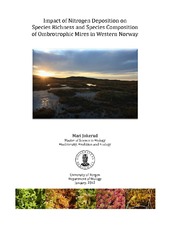| dc.description.abstract | There is almost no research on ombrotrophic mire vegetation and the possible impact of atmospheric nitrogen deposition on species richness and composition in Norway. It is important to detect whether N deposition is impacting this system since this vegetation type is listed as vulnerable' in the Norwegian Red List and since it has low critical loads' for nitrogen. Findings from European research show that deposition of N reduces biodiversity in nutrient poor ecosystems, including ombrotrophic mires. Increased N deposition favours faster growing and larger species, leading to competitive exclusion of plants adapted to low N deposition. As a result, N-sensitive vegetation has declined in European peatlands, heathlands and grasslands since the mid-20th century. The aim of this thesis is to assess changes in species richness and species composition in vascular plants and bryophytes, and to determine whether nitrogen deposition impacts species richness and species composition on ombrotrophic mires in Western Norway. This is investigated over time by performing resample and over space by performing a gradient survey. Two resample surveys were performed, in an southern locality which has been subjected to relatively high levels of N deposition (58°31'40" N, 8°46'43" E and 1357 mgN/m2/year) and a northern locality where N deposition levels have been lower (63°28'53" N, 8°37'19"E and 269 mgN/m2/year) and the gradient was performed between the southern and northern locality. The combination of the two different approaches also allows comparison between different approaches. Changes in occurrence and relative frequency of occurrence over time were investigated using to assess whether species richness had changed. Relative changes in species environmental optima were calculated with Ellenberg environmental indicator values in order to detect which environmental variables that could explain possible changes in species composition. Linear multiple regression model and backward selection was used to assess which environmental gradient that best explains species richness patterns in the gradient study. The findings from both surveys suggest that nitrogen deposition is impacting the mire vegetation in the south where nitrogen deposition is highest and also above the suggested critical load (500-1000 mgN/m2/yr). The southern locality showed decreased species richness and alteration of species composition which are most likely caused by increased N deposition. The northern resampling locality showed changes in terms of increased species richness and alteration of species composition but these changes are probably related to natural succession. The gradient survey support the finding that that N deposition decrease species richness on southern ombrotrophic mires | en_US |
